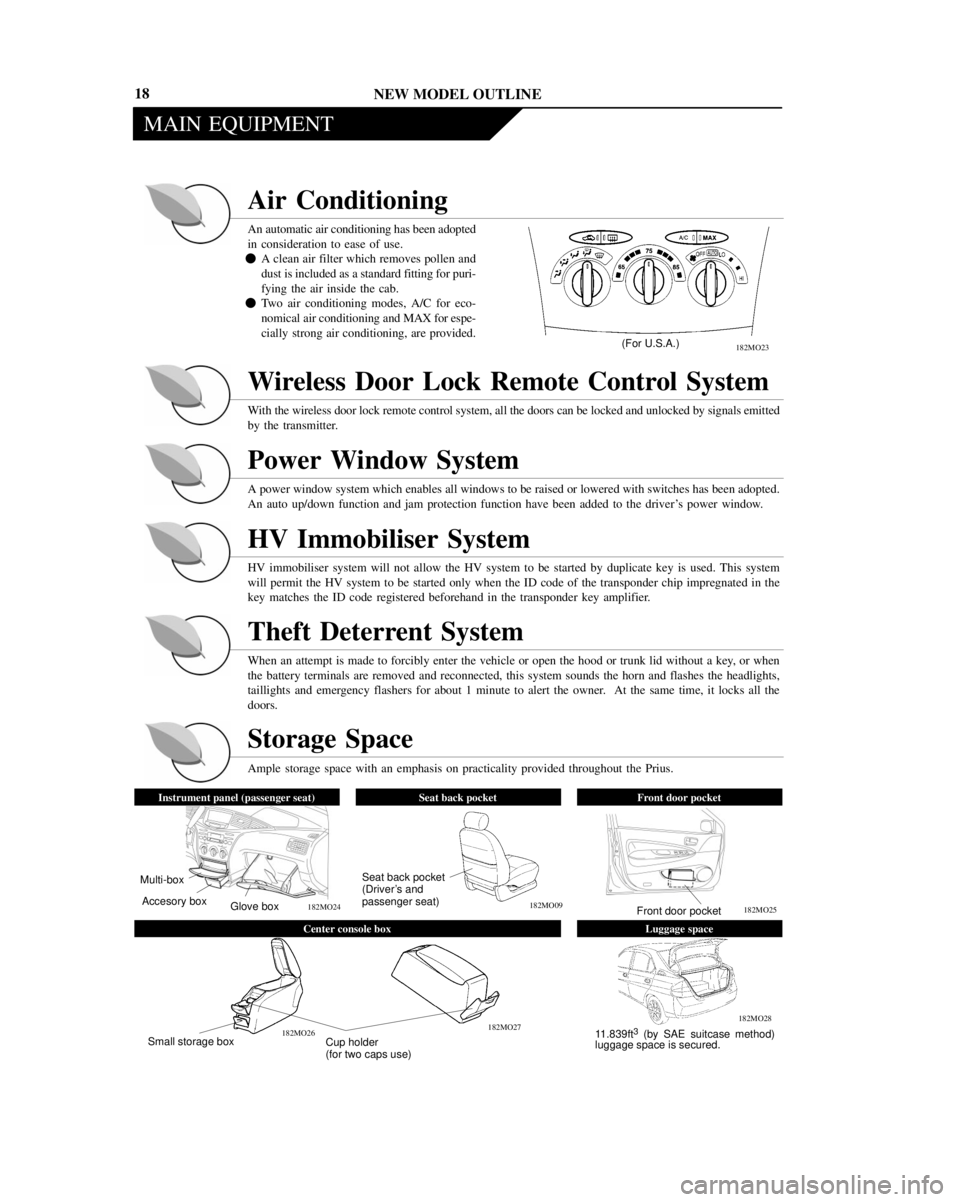Page 277 of 1943

NEW MODEL OUTLINE
MAIN EQUIPMENT
182MO23(For U.S.A.)
Glove box Accesory box Multi-box
Front door pocket
Seat back pocket
(Driver's and
passenger seat)
182MO24182MO09
182MO25
Small storage box
Cup holder
(for two caps use)11.839ft3 (by SAE suitcase method)
luggage space is secured.182MO26182MO27182MO28
18
Air Conditioning
An automatic air conditioning has been adopted
in consideration to ease of use.
�A clean air filter which removes pollen and
dust is included as a standard fitting for puri-
fying the air inside the cab.
�Two air conditioning modes, A/C for eco-
nomical air conditioning and MAX for espe-
cially strong air conditioning, are provided.
Wireless Door Lock Remote Control System
With the wireless door lock remote control system, all the doors can be locked and unlocked by signals emitted
by the transmitter.
Power Window System
A power window system which enables all windows to be raised or lowered with switches has been adopted.
An auto up/down function and jam protection function have been added to the driver's power window.
HV Immobiliser System
HV immobiliser system will not allow the HV system to be started by duplicate key is used. This system
will permit the HV system to be started only when the ID code of the transponder chip impregnated in the
key matches the ID code registered beforehand in the transponder key amplifier.
Theft Deterrent System
When an attempt is made to forcibly enter the vehicle or open the hood or trunk lid without a key, or when
the battery terminals are removed and reconnected, this system sounds the horn and flashes the headlights,
taillights and emergency flashers for about 1 minute to alert the owner. At the same time, it locks all the
doors.
Storage Space
Ample storage space with an emphasis on practicality provided throughout the Prius.
Instrument panel (passenger seat)Seat back pocketFront door pocket
Center console boxLuggage space
Page 278 of 1943

NEW MODEL OUTLINE
SAFETY
182MO30182MO29
182MO31Side Impact Energy
19
Prius ± one step ahead of the rest even in the area of
safety.
Drive with the utmost peace of mind.
Passive Safety Body
The impact absorbing body adopted for the new Prius effectively absorbs and distributes the impact from
front and side collisions to ease the effects of the impact on the driver and passengers, and the high-strength
body structure minimizes deformation of the cabin itself.
[Frontal collision]
The front section of the body frame and under body absorb and
distribute the load generated by a frontal collision, while the strong
cabin frame eases the effect of the impact on the driver and passen-
gers and minimizes deformation of the cabin, thus realizing an ideal
body structure.
The front side member is of a straight design to be deformed
effectively from the front end. Also, in the event of a front
collision, the force of the impact is effectively distributed
to each of the braces and members through the sections
where they join the cabin.
[Side collision]
Along with the ideal body structure which effectively absorbs and distributes the load on the frame in side collisions, we have maintained
the strength of each pillar, rocker panel and door to minimize deformation of the cabin.
Page 281 of 1943
NEW MODEL OUTLINE
POINT1
Exterior
POINT2
Interior
POINT3
Main
Mechanism
POINT4
Main
Equipment
POINT5
Safety
7
Prius ± a 4-door compact sedan
5 Features to lead the way into
the next generation
Futuristic image and symmetry are re-
flected in the artistic design of the new
Prius.
An interior which reflects the type of
comfort that will be regarded as a must in
cars hereinafter.
Low-emission & high-fuel efficiency.
TOYOTA hybrid system leading the way
into the next generation.
A range of features for comfort - the
more you use them, the better it gets.
Prius - one step ahead of the rest even in
the area of safety.
Drive with the utmost peace of mind.
Page 329 of 1943

THS (TOYOTA HYBRID SYSTEM)
182TH33
31
± REFERENCE ±
The MG1 and the MG2 are generally shut down when the shift lever is in the N position.
However, the shut-down function is canceled under the following exceptions:
�During driving, if the brake pedal is depressed and a wheel locks up, the ABS is activated. After this, low
torque is requested from the MG2 to provide supplemental power in order to restart the rotation of the wheel.
Even if the shift lever is in the N position at this time, the shut-down function is canceled to allow the wheel
to rotate. After the wheel rotation has been restarted, the system resumes its shut-down function.
�When the vehicle is driven in the D or B position and the brake pedal is depressed, the regenerative brake
operates. At this time, as the driver moves the shift lever to the N position, the brake hydraulic pressure in-
creases while the request torque of the regenerative brake decreases gradually so as not to create a sluggish
brake feel. After this, the system effects its shut-down function.
When any of the conditions described below is pres-
ent, the message prompt as shown appears in the
multi information display, accompanied by the illu-
mination of the master warning light and the continu-
ous sounding of the buzzer.
�The ªREADYº light is illuminated, the shift lever
is in the N position, and the HV battery is dis-
charged.
�The ªREADYº light is illuminated, the shift lever
is in the N position, and the driver's door is open.
�The ªREADYº light is illuminated, the parking brake is engaged, the shift lever is in the B or D position, and
the driver's door is open.
Page 395 of 1943

BODY ± BODY STRUCTURE
182BO04
182BO05
� Impact Absorbing Structure for Side Collision �
�
Head Impact Protection Structure �
Energy Absorbing
Urethane PadEnergy Absorbing Material
Side Impact
Protection Beams
Side Impact Energy
Side Impact Protection Beam
: Energy Absorbing Rib
: Aluminum Energy
Absorbing Material133
2) Impact Absorbing Structure for Side Collision
�Impact energy of a side collision directed to the cabin area is dispersed throughout the body via pillar
reinforcements, side impact protection beams, floor cross members, thus helping minimize the impact
energy finally directed to the cabin. In addition, the body is made reinforced joints and high strength
sheet steel, in order to help maintain the maximum preservation of the cabin space. And, in order to
make the door energy absorbent, a closed cross section configuration is provided at the belt line area
of the front and rear doors.
�By providing an energy absorbing urethane pad in the front door panel and an energy absorbing mate-
rial in the door panel and the center pillar garnish, the impact of a collision can be dampened.
�A head impact protection structure has been adopted. With this type of construction, if the occupant's
head hits against the roof side rail and pillar in reaction to a collision, the inner panel of the roof side
rail and pillar collapses to help reduce the impact.
Page 396 of 1943
BODY ± RUST-RESISTANT BODY
182BO06
: Anti-Corrosion Sheet Steel 134
�RUST-RESISTANT BODY
1. General
Rust-resistant performance is enhanced by extensive use of anti-corrosion sheet steel and an anti-corrosion
treatment by applying wax, sealer and anti-chipping paint to easily corroded parts such as the hoods, doors
and rocker panels.
2. Anti-Corrosion Sheet Steel
Anti-corrosion sheet steel is used in all areas other than the roof and interior parts.
Page 397 of 1943
BODY ± RUST-RESISTANT BODY
182BO07
: Edge Seal
: PVC Coating
Area
182BO08
: Anti-Chipping Paint
: PVC Chipping Primer
135
3. Wax and Sealer
Wax and sealer are applied to the hemmed portions of the hoods, door panels, rocker panel and luggage
compartment door to improve rust-resistant performance.
4. Under Coat
PVC (Polyvinyl Chloride) coating is applied to the under side of the body.
The bottom side of the cowl panel, the fender apron and other parts which are subject to damage by stone
chipping.
5. Anti-Chipping Application
Anti-chipping paint and PVC chipping primer are applied to the lower quarter panel area, lower door panel
area, front hood area and the rocker panel area to protect them from stone chipping.
Page 403 of 1943

BODY ELECTRICAL
BODY ELECTRICAL ± BATTERY AND MULTIPLEX COMMUNICATION SYSTEM
182BE01
: BEAN : UART
: AVC-LAN : Serial Data
Link
Brake ECU
HV ECU
Air Condi-
tioning ECU
Meter ECU
ECM
Body ECU
Display ECU
Audio
ComponentsGateway
ECU
Power Window
Master SwitchDoor Con-
trol ReceiverBattery ECU
141
AUXILIARY BATTERY
�DESCRIPTION
All the body electrical systems and auxiliary equipment operate using the same 12 V battery used on ordinary
gasoline engine vehicles.
However, as the battery structure is different, Prius uses an exclusive battery. See page 42 in the THS (TOYOTA
Hybrid System) section for details of the auxiliary battery structure.
MULTIPLEX COMMUNICATION SYSTEM
�DESCRIPTION
�A multiplex communication system has been adopted for body electrical system control and to achieve
a slimmer wiring harnesses configuration.
�BEAN (Body Electronics Area Network) has been adopted between the body ECU, ECM, meter ECU,
air conditioning ECU, and the gateway ECU. Furthermore, AVC-LAN (Audio Visual Communication-
Local Area Network) has been adopted between the display ECU and the audio components.
The conversion of communication signals between BEAN and AVC-LAN is performed by the gateway
ECU.
�UART (Universal Asynchronous Receiver Transmitter), which performs unidirectional communication,
has been adopted between the body ECU and the power window master switch.
�A serial data link has been adopted between the body ECU and the door control receiver. In addition, a
serial data link has been adopted between the ECM, HV ECU, brake ECU, and the battery ECU, which
pertain to the control of the hybrid system.
� System Diagram �